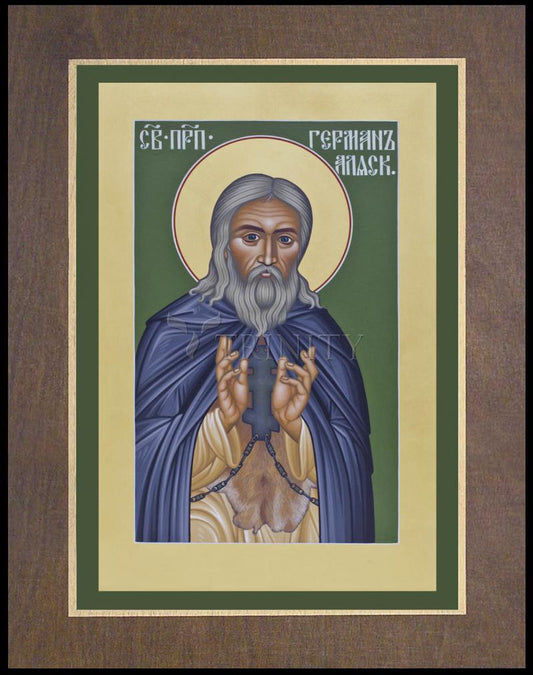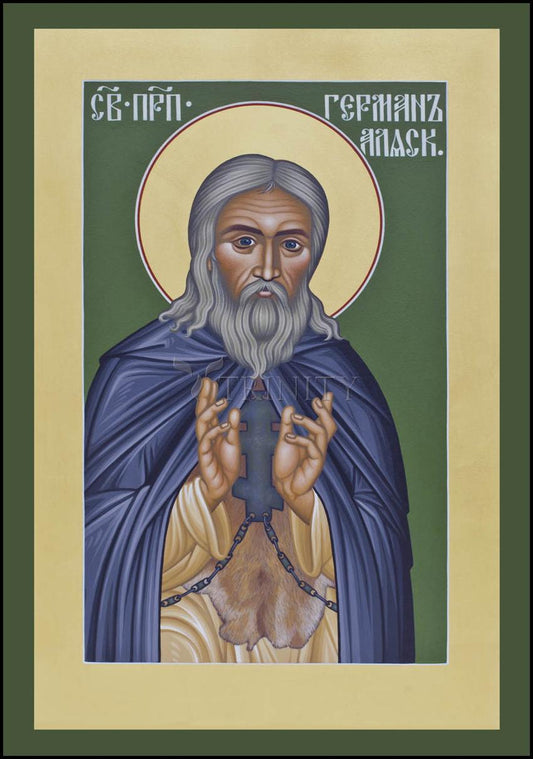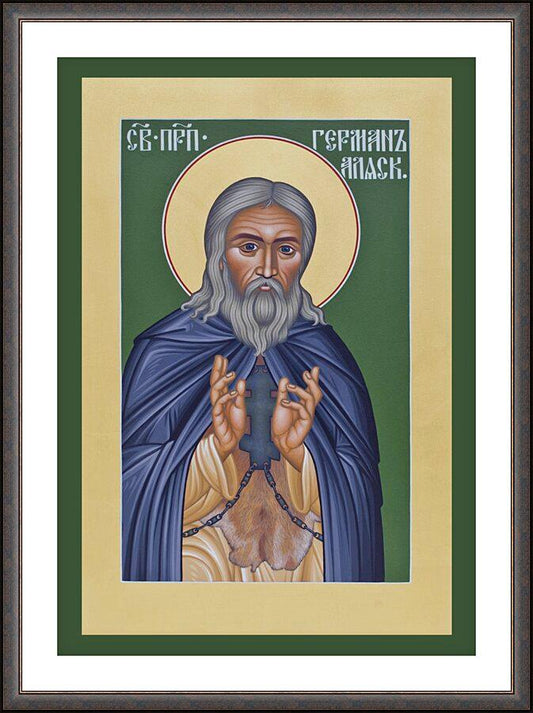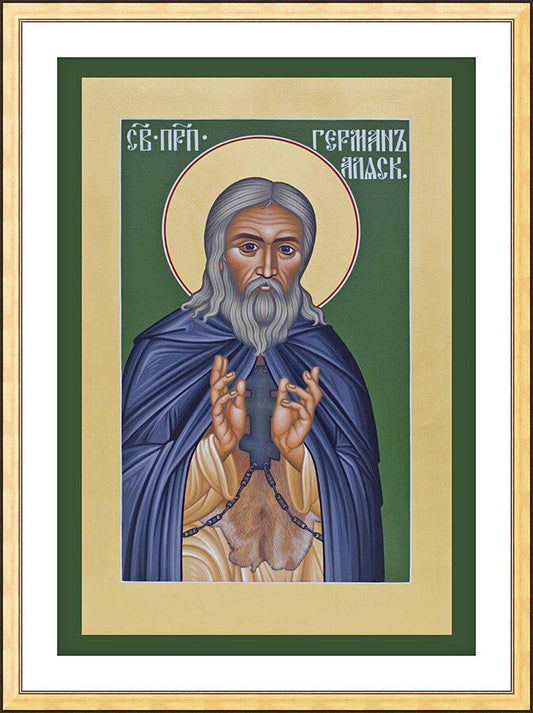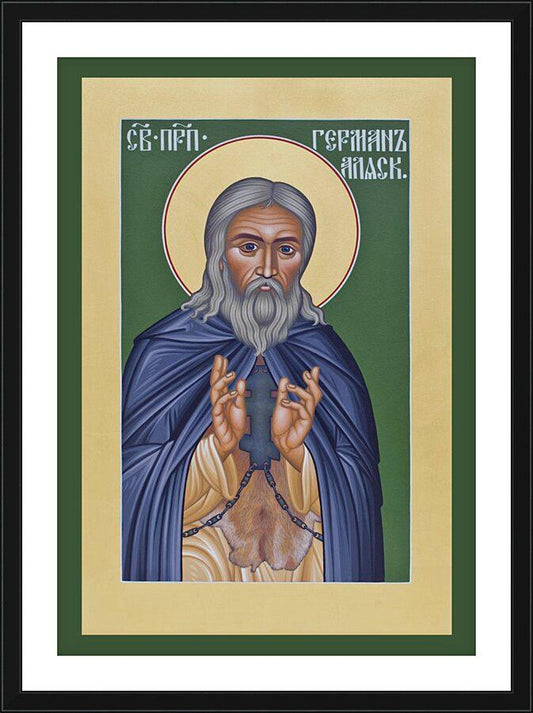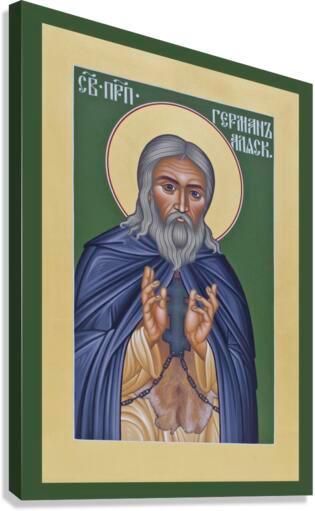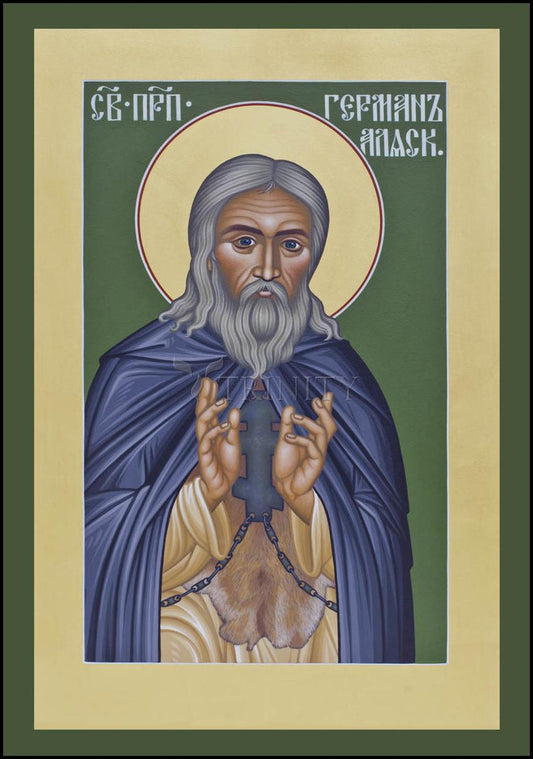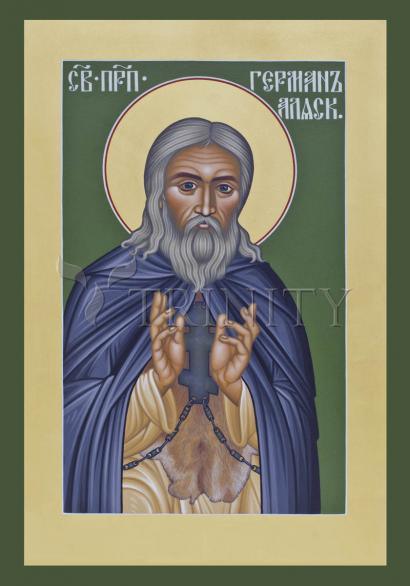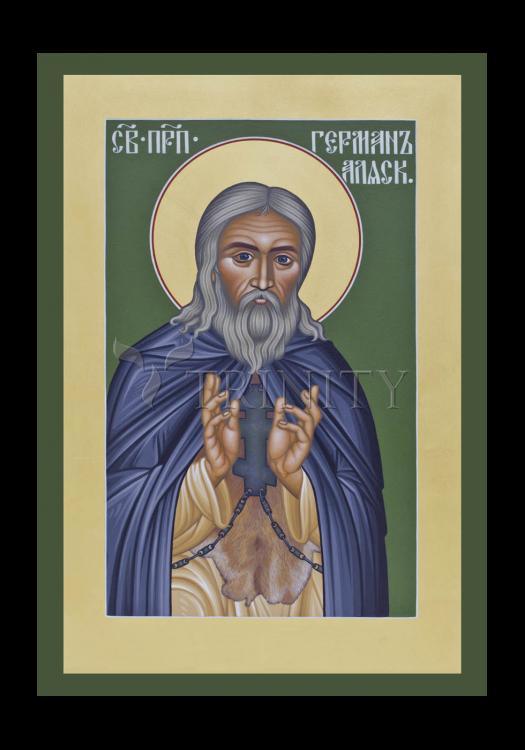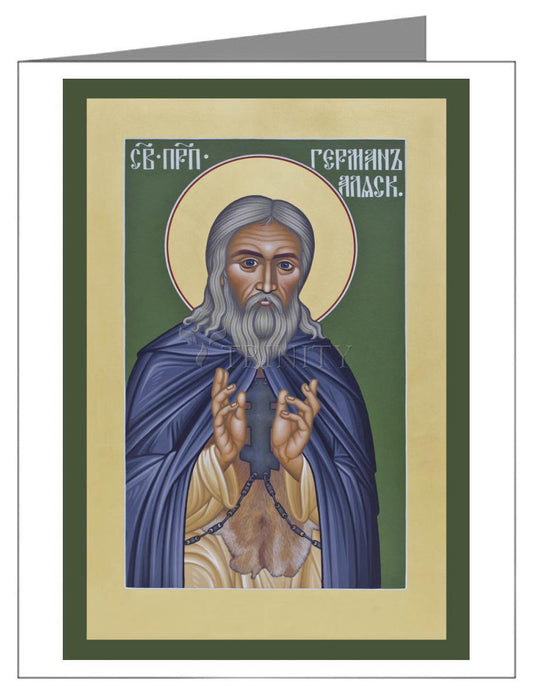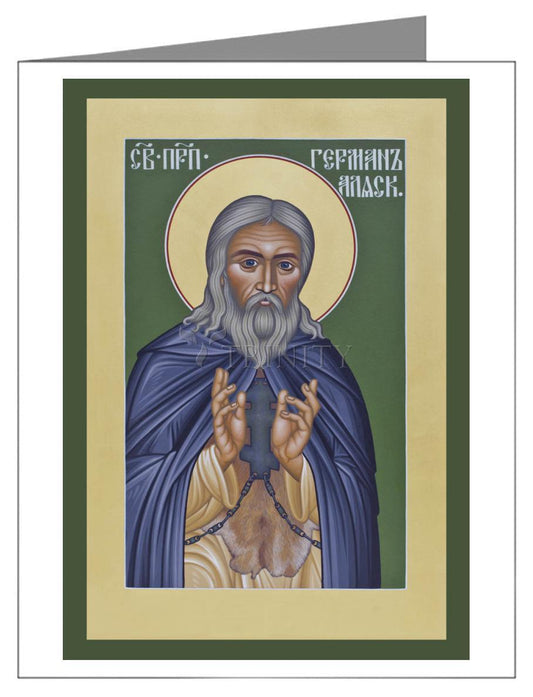A spiritual mission was organized in 1793, made up of monks of the Valaam Monastery. They were sent to preach the Word of God to the native inhabitants of northwestern America, who only ten years before had come under the sovereignty of Russia. St Herman was among the members of this Mission.
St. Herman came from a family of merchants of Serpukhov, a city of the Moscow Diocese. His name before he was tonsured and his family name are not known. (The monastic name is given when a monk takes his vows). He had a great zeal for piety from youth, and at sixteen he entered monastic life. (This was in 1772, if we assume that Herman was born in 1756, although sometimes 1760 is given as the date of his birth). First he entered the Trinity-Sergius Hermitage which was located near the Gulf of Finland on the Peterhof Road, about 15 versts (about 10 miles) from St Petersburg.
MIRACULOUS HEALING OF HERMAN
The following incident happened to Father Herman at the St. Sergius Hermitage. An abscess appeared on the right side of his throat under his chin. The swelling grew rapidly, disfiguring his face. It became difficult for him to swallow, and the odor was unbearable. In this critical condition Father Herman awaited death. He did not appeal to a physician of this world, but locking his cell he fell before an icon of the Queen of Heaven, he prayed with fervent tears, asking Her that he might be healed. He prayed the whole night. Then he took a wet towel and with it wiped the face of the Most Holy Mother, and with this towel he covered the swelling. He continued to pray with tears until he fell asleep on the floor from sheer exhaustion. In a dream he saw the Virgin Mary healing him.
When Herman awoke in the morning, he found to his great surprise that he was fully healed. The swelling had disappeared; even though the abscess had not broken through, leaving behind but a small mark as though a reminder of the miracle. Physicians to whom this healing was described did not believe it, arguing that it was necessary for the abscess to have either broken through of its own accord or to have been cut open. But the words of the physicians were the words of human experience; for where the grace of God operates there the order of nature is overcome. Such occurrences serve to humble human reason under the strong hand of God's Mercy.
HERMAN'S LIFE AT VALAAM
For five or six years Father Herman continued to live in the St. Sergius Hermitage, and then he transferred to the Valaam Monastery, which was widely scattered on the large islands in the waters of the great Lake Ladoga. He came to love the Valaam haven with all his soul, as he came to love its unforgettable Superior, the pious Elder Nazarius, and all the brethren. He wrote to Father Nazarius later from America, "Your fatherly goodness to me, humble one, will be erased out of my heart neither by the terrible, impassable Siberian lands, nor by the dark forests. Nor will it be wiped out by the swift flow of the great rivers; nor will the awful ocean quench these feelings. In my mind I imagine my beloved Valaam, looking to it beyond the great ocean." He praised the Elder Nazarius in his letters as "Most Reverend, and my beloved father." (Batushka) and the brethren of Valaam he called, "my beloved and dearest." The place where he lived in America, deserted Spruce Island, he called "New Valaam." And as we can see, he always remained in spiritual contact with his spiritual homeland', for as late as 1823, that is after thirty years of his life within the borders of America, he wrote letters to the successor of Father Nazarius, the lgumen Innocent.
Father Barlaam, later lgumen of Valaam, and a contemporary of Father Herman, who accepted his tonsure from Father Nazarius, wrote thus of the life of Father Herman.
"Father Herman went through the various obediences here, and being 'well disposed toward everything' was in the course of events sent to Serdobol to oversee there the work of quarrying marble. The Brothers loved Father Herman, and waited impatiently his return to the cloisters from Serdobol. Recognizing the zeal of the young hermit the wise elder, Father Nazarius, released him to take abode in the wilderness. This wilderness was in the deep forest about a mile from the cloister: to this day this place has retained the name 'Herman's.' On holy days, Father Herman returned to the monastery from the wilderness. Then it was that at Little Vespers he would stand in the choir and sing in his pleasant tenor the responses with the brethren from the Canon, 'O Sweetest Jesus, save us sinners. Most Holy Theotokos, Save us,' and tears would fall like hail from his eyes."
THE FIRST MISSION TO AMERICA
In the second half of the 18th century the borders of Holy Russia expanded to the north. In those years Russian merchants discovered the Aleutian Islands which formed in the Pacific Ocean a chain from the eastern shares of Kamchatka to the western shares of North America. With the opening of these islands there was revealed the sacred necessity to illumine with the light of the Gospel the native inhabitants. With the blessing of the Holy Synod, Metropolitan Gabriel gave to the Elder Nazarius the task of selecting capable persons from the brethren of Valaam for this holy endeavor. Ten men were selected, and among them was Father Herman. The chosen men left Valaam for the place of their great appointment in 1793. (The members of this historical mission were: Archimandrite Joseph (Bolotoff), the Hieromonks Juvenal, Macarius, Athanasius, Stephan and Nectarius, Hierodeacons Nectarius and Stephen, and the monks Joasaph, and Herman).
As a result of the holy zeal of the preachers the light of the evangelic sermon quickly poured out among the sons of Russia, and several thousand pagans accepted Christianity. A school for the education of newly-baptized children was organized, and a church was built at the place where the missionaries lived. But by the inscrutable providence of God the general progress of the mission was unsatisfactory. After five years of very productive labor, Archimandrite Joasaph, who had just been elevated to the rank of bishop, was drowned with his party. (This occurred in the Pacific Ocean been Kamchatka and the Aleutian Islands. The ship, Phoenix, one of the first sea-going ships built in Alaska, sailed from Okhotsk carrying the first Bishop for the American Mission and his party. The Phoenix was caught in one of the many storms which periodically sweep the northern Pacific, and the ship and all hands perished together with Bishop Joasaph and his party.) Before this the zealous Hieromonk Juvenal was granted the martyr's crown. The others died one after another until in the end only Father Herman remained. The Lord permitted him to labor longer than any of his brethren in the apostolic task of enlightening the Aleutians.
NEW VALAAM - SPRUCE ISLAND
In America Father Herman chose as his place of habitation Spruce Island, which he called New Valaam. This island is separated by a strait about a mile and a quarter wide from Kodiak Island on which had been built a wooden monastery for the residence of the members of the mission, and a wooden church dedicated to the Resurrection of the Savior. (New Valaam was named for Valaam on Lake Ladoga, the monastery from which Father Herman came to America. It is interesting to note that Valaam is also located on an island, although, this island is in a fresh water lake, whereas, Spruce Island is on the Pacific Ocean, although near other islands and the Alaskan mainland).
Spruce Island is not large, and is almost completely covered by a forest. Almost through its middle a small brook flows to the sea. Herman selected this picturesque island for the location of his hermitage. He dug a cave out of the ground with his own hands, and in it he lived his first full summer. For winter a cell was built for him near the cave in which he lived until his death. The cave was converted by him into a place for his burial. A wooden chapel, and a wooden house to be used as a schoolhouse and a guest house were built not too distant from his cell. A garden was laid out in front of his cell. For more than forty years Father Herman lived here.
FATHER HERMAN'S WAY OF LIFE
Father Herman himself spaded the garden, planted potatoes and cabbage and various vegetables in it. For winter, he preserved mushrooms, salting or drying them. The salt was obtained by him from ocean water. It is said that a wicker basket in which the Elder carried seaweed from the shore, was so large that it was difficult for one person to carry. The seaweed was used for fertilizing the soil. But to the astonishment of all, Father Herman carried a basket filled with seaweed for a long distance without any help at all. By chance his disciple, Gerasim, saw him one winter night carrying a large log which normally would be carried by four men; and he was bare footed. Thus worked the Elder, and everything that he acquired as a result of his immeasurable labors was used for the feeding and clothing of orphans and also for books for his students.
His clothes were the same for winter as for summer. He did not wear a shirt; instead he wore a smock of deer skin, which he did not take off for several years at a time, nor did he change it, so that the fur in it was completely worn away, and the leather became glossy. Then there were his boots or shoes, cassock (podrasnik), an ancient and faded out cassock (riasa) full of patchwork, and his headdress (klobuk). He went everywhere in these clothes, and at all times; in the rain, in snowstorms, and during the coldest freezing weather. In this, Father Herman followed the example of many Eastern Ascetic Fathers and Monks who showed the greatest concern for the welfare and needs of others. Yet, they themselves wore the oldest possible clothes to show their great humility before God, and their contempt for worldly things.
A small bench covered with a time-worn deerskin served as Father Herman's bed. He used two bricks for a pillow; these were hidden from visitors by a skin or a shirt. There was no blanket. Instead, he covered himself with a wooden board which lay on the stove. Father Herman himself called this board his blanket, and he willed that it be used to cover his remains; it was as long as he was tall. "During my stay in the cell of Father Herman," writes the Creole Constantine Larionov, "I, a sinner, sat on his 'blanket'-and I consider this the acme of my fortune!" ('Creole' is the name by which the Russians referred to the children of mixed marriages of native Indians of Alaska, Eskimo and Aleuts with Russians).
On the occasions when Father Herman was the guest of administrators of the American Company and in the course of their soul-saving talks he sat up with them until midnight. He never spent the night with them, but regardless of the weather he always returned to his hermitage. If for some extraordinary reason it was necessary for him to spend the night away from his cell, then in the morning the bed which had been prepared for him would be found untouched; the Elder not having slept at all. The same was true in his hermitage where having spent the night in talks, he never rested.
The Elder ate very little. As a guest, he scarcely tasted the food, and remained without dinner. In his cell his dinner consisted of a very small portion of a small fish or some vegetables.
His body, emaciated as a result of his labors, his vigils, and fasting, was crushed by chains which weighed about sixteen pounds. These chains are kept to this day in the chapel.
Telling of these deeds of Father Herman, his disciple, the Aleut lgnaty Aligyaga added, "Yes, Apa led a very hard life. No one can imitate his life!" (Apa, Aleutian word means Elder or grandfather, and it is a name indicative of the great affection in which he was held).
Our writing of the incidents in the life of the Elder deal, so to speak, with the external aspects of his labor. "His most important works," says the Bishop Peter, "were his exercises in spiritual endeavor in his isolated cell where no one saw him, but outside the cell they heard him singing and celebrating services to God according to the monastic rule." This witness of the Bishop is supported by the following answers of Father Herman, himself, "How do you manage to live alone in the forest, Father Herman? Don't you ever become lonesome?" He answered, "No I am not there alone! God is here, as God is everywhere. The Holy Angels are there. With whom is it better to talk, with people, or with Angels? Most certainly with Angels."
Born: 1756
Died: 12 December 1837
"”Excerpts from "œGlorification of the Venerable Herman of Alaska, Wonderworker of All America", Orthodox Church of America



